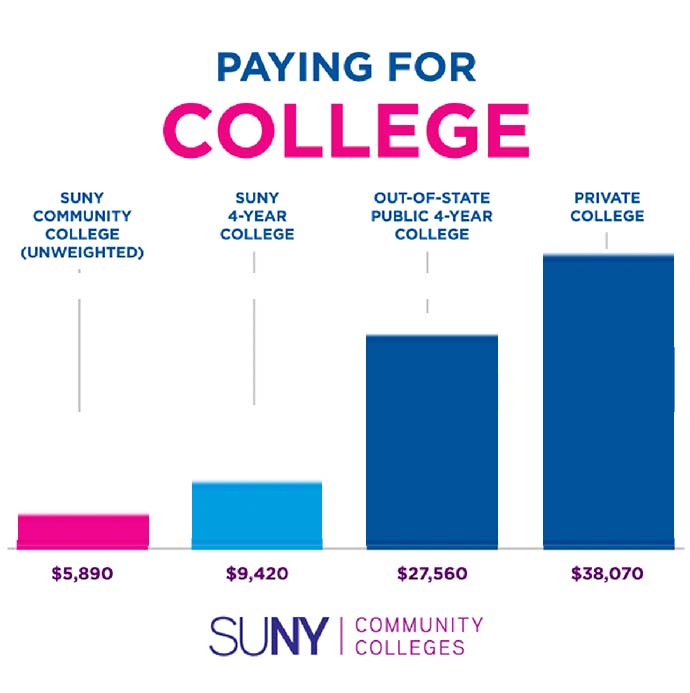
Online education provides opportunities to obtain a college degree for many people who simply can’t commit to the traditional college experience. These online degrees aren’t just in limited or odd fields. They cover the entire spectrum of college learning opportunities. Their variety is what makes them one of the fastest growing segments in education.
With so many options, choosing an online degree can be overwhelming and stressful. At SUNY, our SUNY Online admissions coaches offer their advice to help you choose the best, reputable online degree for your needs:
- Know what kinds of degrees you can get online
- Narrow down your list
- Learn the differences in accreditation
- Ask about transferring your credits
- Compare the actual tuition costs
- Apply for financial aid
- Choose the best fit for you at the time and for the future
Types of degrees and programs online
Colleges and universities offer many types of programs online, such as:
- Individual classes
- Microcredentialing programs
- Undergraduate certificates, which are typically 1-year programs
- Associate degrees, which are 2-year degree programs
- Bachelor’s degrees, which are 4-year degrees
- Graduate certificates, which require at least a bachelor’s degree
- Graduate degrees such as master’s and PhDs
The advancement of online degrees makes it easier for students to study practically anything online and in any field. Common online degree areas are computer science and IT, accounting, business, criminal justice, law, social sciences, engineering, languages, education, cultural studies, and more.
In most cases skilled trades, nursing, and other hands-on careers cannot be completed online; however, some of the classes in a program may be offered online to accommodate students’ needs.
Narrow down your list
For many, starting the search for an online degree is easier because they know exactly what they want. For those who still don’t know what they want to do, consider three questions:
- What do you want to learn – a new skill, a specific skill, a field?
- What do you want to earn – a certificate, undergraduate degree, badge, or a graduate degree?
- What do you want to be? If you have a career path in mind, work backwards to understand the education or training required to get there.
If you still don’t know, talk to an advisor about taking required general education courses first or enrolling in an individual studies degree.
Understanding the buzzworthy word “accreditation”
Take a moment to search “accredited online degrees.” While the search engine quickly provides more than 3 BILLION results, there is nothing quick about navigating the differences in the types of accreditations and what they mean for you as a student.
In a previous post, we talked about the differences in regional, national, and specialized accreditation.
There are four ways in which you can find out if a college is accredited:
- Visit the college’s website. Either type it in the search box or navigate to the “about us” section or something similar. If you are looking for program-specific accreditation, visit the program page.
- If you are looking for a specific type of accreditation, visit the accreditor’s website to do a search.
- Search for the college on the Department of Education’s website.
- Visit CHEA’s accreditation search tool to find accredited schools and programs.
Ask About Transferring Credits
Transfer credits can come from traditional and nontraditional sources. Traditional types of transfer credits come from a current degree, previous colleges, stackable microcredentials, and college in the high school classes.
Common sources for non-traditional types of credits include prior learning assessments, courses taken from online providers, military credits, FEMA, CLEP/DSST, international baccalaureate (IB), advanced placement (AP) credits, and more. Here is what you need to know:
- Some colleges may be more likely to award credits for general education or other electives than program core requirements
- Prior learning credits or credit for what you learned in the workforce may be completed but only after a formal application and review process.
- Not all colleges have the same transfer credit policies, so a transcript evaluation is necessary to understand who accepts what and how that affects your time to degree.
You must have an official transcript for all of the credits you want evaluated.
Compare the ACTUAL Cost
Okay, you found a couple programs, you know how many credits you need to take to earn a degree, and now it is time to sign – right? No, you still need to understand what the actual cost to attend is. Be careful of advertisements that offer deep discounts without understanding what your actual tuition cost is. All colleges must publish their tuition costs, and as an online student, you need to know what to look for:
- If you are an in-state student, meaning you are a resident of the state where the college is located, do you pay the same tuition rate as an on-campus student, or is there a specific online tuition rate?
- If the online college is not in your state, as an online student, are you subject to out-of-state tuition costs or a standard online tuition?
- What fees are charged for the program?
- If you are a state resident, make sure you ask about specific in-state tuition assistance programs. Do you lose access to those funds when you attend an online college out of state? Common NYS-specific tuition assistance programs are TAP, Excelsior Scholarship, and the Nurse for our Future Scholarship.
- Do scholarships affect the amount of financial aid for which you are eligible?
To easily compare tuition across multiple colleges, visit tools such as Tuition Tracker or the state’s Department of Education. While you are there, evaluate completion rates too.

Apply for financial aid
Apply for financial aid – always. Visit studentaid.gov to fill out a free FAFSA form. The FAFSA is used to determine your federal aid eligibility and by states and colleges to award their own aid. The most common types of financial aid are:
- Grants
- Loans
- Scholarships
- Work-study programs
Evaluate every award letter and fully understand exactly how much you will receive and have to pay. If funding gaps exist. You need to know how much comes out of pocket now and how much debt load you may have to carry after graduation.
Choose the best online program for you at the time and for the future
Consider your time now and what you want to do in the future. Flexibility is a key feature of online learning, and not all programs require you to jump right into a full-time bachelor’s degree. There is a lot to expect as an online student (link to post), and different pathways allow for you to earn your degree or to upskill in a format that works for you. Options for choosing the best online program can be:
- Starting out as a part-time student so you ease into college with a manageable workload;
- Using the credits, you already have, if fewer than 45-60, to finish an associate degree at a community college online first, which allows you to transfer as a junior to a 4-year college;
- Starting with a stackable microcredential that gives you the flexibility to ease into a field while earning credit for the courses you take. You earn a badge for your resume and credit for classes that transfer.
- Choosing a bachelor’s degree program that accepts the most transfer credits and offers you the most funding as an online student.
- Earning a graduate certificate before enrolling in a master’s or doctoral program; or
- Adding a certificate or badge as part of your online graduate program.
To learn more about online learning at SUNY, contact SUNY or visit the expansive catalog of online courses and degrees.



